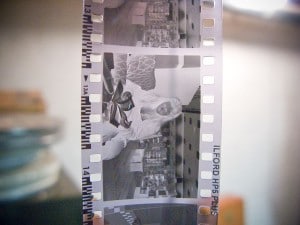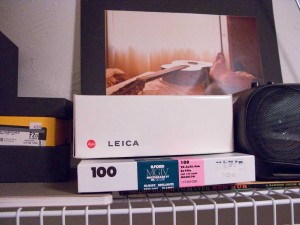 Despite not writing a word about this since April 2008 the project has continued. This evening I was processing film in the darkroom. Back in November photography ground to a halt as my friend Gordon and I began to edit our images and put together a Blurb book. For me that’s a difficult process and one I go to great lengths to avoid. I’m finally wrapping up work on the 24 or so images that will appear in the book reflecting my experience with the project.
Despite not writing a word about this since April 2008 the project has continued. This evening I was processing film in the darkroom. Back in November photography ground to a halt as my friend Gordon and I began to edit our images and put together a Blurb book. For me that’s a difficult process and one I go to great lengths to avoid. I’m finally wrapping up work on the 24 or so images that will appear in the book reflecting my experience with the project.
 It’s good to be back in the darkroom processing film. This evening it was two rolls of 35mm Ilford HP5 processed in ZonalPro film developer. A heady affair with a new Nikon D700 digital SLR camera keep my Leica M6 in the camera bag for a long time but now we’re back together, the Leica my primary creative sketching tool. The D700 is an amazing tool and can do things I did not think possible. But after the glow of newness faded I found it cold, empty, and without the magic I feel shooting, processing film and making prints in a darkroom.
It’s good to be back in the darkroom processing film. This evening it was two rolls of 35mm Ilford HP5 processed in ZonalPro film developer. A heady affair with a new Nikon D700 digital SLR camera keep my Leica M6 in the camera bag for a long time but now we’re back together, the Leica my primary creative sketching tool. The D700 is an amazing tool and can do things I did not think possible. But after the glow of newness faded I found it cold, empty, and without the magic I feel shooting, processing film and making prints in a darkroom.
 Darkrooms are cozy places and maybe sometime I’ll try and make a picture that depicts that feeling. But even with the lights on a see a lot of comforting things around. And once the lights go down, the sound of water running, and some soft music, well, it is a great place to work.
Darkrooms are cozy places and maybe sometime I’ll try and make a picture that depicts that feeling. But even with the lights on a see a lot of comforting things around. And once the lights go down, the sound of water running, and some soft music, well, it is a great place to work.
Hi Steve,
I love the description of your comfort and coziness in your darkroom.
Kind of like winter for me…a time and place to keep it simple, familiar, quiet, low key, and dreamy.
Tim
Dear Sir:
A friend of mine has ben a professional photographer for over 30 years. I remember being in his darkroom, with the water running, flicking the lights on and off, and the glow of the red working light.
But that was years ago. It almost seems like another life.
Fondest regards,
Jack
Twisted Roads
Hmm,somebody has money to have a D700!
My dream Nikon but at C$3500.00- way out of reach. The house gets a new roof this year, then maybe the D700.
However as one who enjoys darkroom work, the processing of film manually, closing the dark room door (wouldn’t want the dark to escape, would we?) Then locking the door, making sure everything is lined up to use, killing the lights, popping the end cap off the film canister, withdrawing the spool, grabbing the stainless steel reel and carefully threading the exposed film on the reel making sure it doesn’t buckle. INto the tank goes the reel and then the second roll, same procedure, put the cap on the container, and then start the process, Shake shake, settle shake. The GraLab timer on the far wall is your guide. Soon the whole process is complete.
Rinse the film making sure the roll
looks OK, clip the top of the roll squeege the film (I use wetting agent)and my fingers, and clip and weight the roll and hang in the drying cabinet. Do the same tothe other roll, Only now turn on the lights and clean up. So simple and yet so darn satisfying.
And then at a later date do the printing under the safe light. There is nothing more magical than watching a sheet of printing paper slowly allow an image to emerge
in the developer. Magic!
And that Steve is what it’s all about. Sure I use PhotoShop CS3 on the Mac and do graphics, however the real dark room bit is still the real thing. Our ancestors will not know what they are missing.
Hi Steve
I know exactly what you meant about the sterility of digital cameras. I have written quite extensively about it on my blog.
I have been shooting film as a photo journalist for over 30 years and somehow the whole process seems more real than creating an image using pixels as the medium.
There is something wonderful and tactile about opening a film canister and operating the winding crank of a Leica (how I regret selling my M3)or a 50 year-old Voigtlander or Kodak Retina. As you may have gathered, I am somewhat partial to classic cameras.
That being said, no matter how hard I try not to like digital, it is darn convenient, cheap and phenomenal.
~Hilton~
http://www.thelightstuff.blogspot.com
The musings of a photo journalist
Glad to know this project is still alive and kicking. I look back through the 3 prints archive from time to time, and I’m always impressed by the results.
What kind of developer is Zonal Pro?
Steve: As an analogue photographer/camera collector, I am getting a renewed interest getting back to film. I enjoy shooting with anything OLD, esp folders. I have a few Leicas but don’t use them much in favour of MF (or LF), or my modern Mamiya 7 kit. I recently dusted off my Certo-Six and LTM IIIb loaded with my expired APX400 to be developed in Divided D-76 (formula I got from my friend Tom Abrahamsson of Rapidwinder.com fame). I have a batch which was mixed up over 6 years ago, but I’m going to use it anyway.
I still have my darkroom/enlargers and developing stuff just crying to be used
bob
bobskoot: wet coast scootin
Tim: A good darkroom is like a secret garden. I forget how comforting a place it can be. As strange as it sounds it I find the same sort of feeling as I do when I ride in the woods…
Jack: I started working in a darkroom when I was a kid and continued ever since. Years ago merge into today.
I remember one big multi-station darkroom I worked in. We would turn all the lights off and play hide and go seek. It always amazed me how big that place was and how many places there were to hide in the dark.
And of course putting a voltage control on your partner’s enlarger with little variations as he tried to make test prints…
I wonder if there are parallel experiences in digital studios?
Bryce: It won’t take long for the D700 to drop in price. It has already declined since I acquired this one. It is a really nice camera.
Your description of the film processing ritual is just so familiar. I bet I have run thousands of rolls just like that since I started as a kid. As we get farther away from the darkroom I think young people will continue to find it, at least some, and they will happily pronounce that are involved in an antique process.
Maybe I will try coating some glass plates in my spare time…
Hilton: I agree with everything you said in your comparison of film and digital. I have to admit though for my professional work I really like digital. It is fast, clean, and I get instant feedback.
I realized it again while shooting a routine assignment that you can see HERE.
matt~:Thanks for your kind words about 3 Prints but I have to say you are the one with an impressive body of work. I am always amazed at how much you do. And now I can follow in real time with Twitter!
ZonalPro is a product sold in our local camera shop. It is manufactured by Alta Photographics. I started using it when I grew tired of mixing powders. But I miss the predictability of Dektol and the longtime comfort of D-76 1:1.
Hell, I even like writing it!
bob: If I had a lot of money and space I could see myself having a lot of cameras. And scooters. And motorcycles. And… well.
I like film. And it does things I can’t or won’t do digitally. I have a Mamiya 7 that I have just not warmed to for some reason. I got it after I sold the 8×10 and I bet I haven’t run a dozen rolls through it.
I’ve been looking again at 4×5 cameras and have my eye on a Wisner Technical field camera. Just what I need. *not sarcasm*
And I have my Zero Image pinhole camera that Kim bought me. Talk about romance— the fact that she got it for me and the luscious feel. Of the camera that is.
Like you said there is a lot of photo gear crying to be used. I am amazed I get to ride the Vespa at all.
Further to photographic dark rooms:
http://www.richardnicholson.com/darkroom/